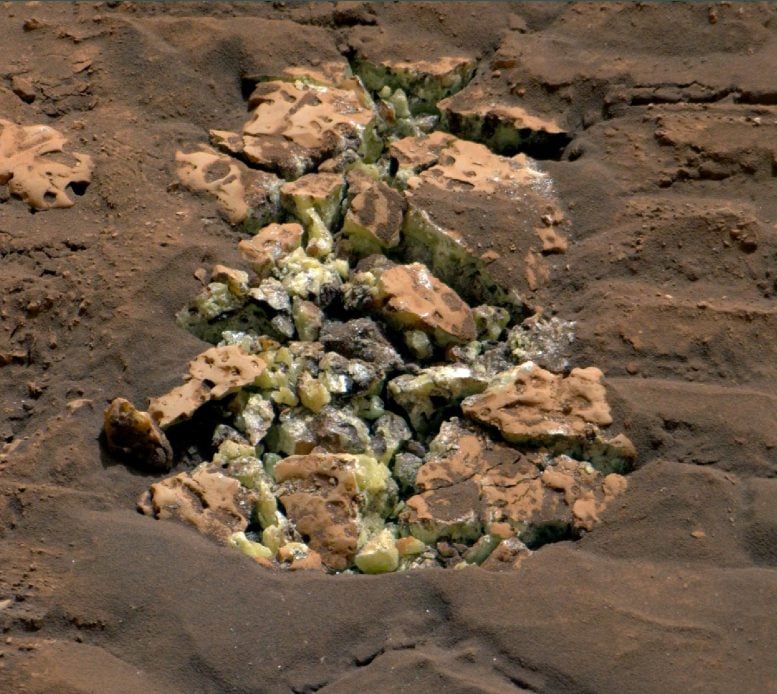
The yellow crystals were discovered after NASA’s Curiosity rover hit a rock and shattered it on May 30. Using an instrument on the rover’s arm, scientists later determined that the crystals were elemental sulfur — the first time this type of sulfur has been found on the Red Planet. Credit: NASA/JPL-Caltech/MSSS
Among several recent discoveries, the rover found rocks made of pure sulfur, a first on the red planet.

NASA’s Curiosity rover captured this close-up image of a rock nicknamed “Snow Lake” on June 8, 2024, the 4,209th Martian day, or sol, of the mission. Nine days earlier, the rover had crushed a similar-looking rock and revealed crystalline textures — and elemental sulfur — inside. Credit: NASA/JPL-Caltech/MSSS
“Discovering a field of rocks made of pure sulfur is like finding an oasis in the desert,” said Curiosity project scientist Ashwin Vasavada of NASA’s Jet Propulsion Laboratory in Southern California. “It shouldn’t be there, so now we have to explain it. Discovering strange and unexpected things is what makes planetary exploration so exciting.”
It’s one of several discoveries Curiosity has made as it travels through the Gediz Vallis channel, a gorge that runs partway down the 5-kilometer-high Mount Sharp (pictured below), whose base the rover has been climbing since 2014. Each layer of the mountain represents a different period in Mars’ history. Curiosity’s mission is to study where and when the planet’s ancient terrain might have provided the nutrients needed for microbial life, if microbial life ever formed on Mars.

Mount Sharp rises about 5.5 kilometers (3.4 miles) above the floor of Gale Crater. This oblique view of Mount Sharp is derived from a combination of elevation data and imagery from three Mars orbiters. The view is looking southeast. Gale Crater is 154 kilometers (96 miles) across. Credit: NASA/JPL-Caltech/ESA/DLR/FU Berlin/MSSS
Floods and avalanches
Spotted from space years before Curiosity launched, the Gediz Vallis channel is one of the main reasons the science team wanted to visit this part of Mars. Scientists believe the channel was carved by flows of liquid water and debris that left a ridge of rock and sediment stretching 2 miles (3 km) down the mountainside below the channel. The goal was to better understand how this landscape changed billions of years ago, and while recent clues have helped, there’s still much to learn about this spectacular landscape.
Since Curiosity arrived in the channel earlier this year, scientists have been investigating whether ancient floodwaters or landslides formed the large mounds of debris that rise from the channel floor at this location. Curiosity’s latest clues suggest that both played a role: Some clumps were likely left by violent flows of water and debris, while others appear to be the result of more local landslides.
Scroll through this 360-degree video to explore the Gediz Vallis channel, where NASA’s Mars rover Curiosity discovered sulfur crystals and drilled its 41st rock sample. The images that make up this mosaic were captured by the rover’s MastCam in June. Credit: NASA/
” data-gt-translate-attributes=”({“attribute”:”data-cmtooltip”, “format”:”html”})” tabindex=”0″ role=”link”>JPL-Caltech/MSSS
These conclusions are based on the rocks found in the debris mounds: while stones carried by flowing water become rounded like river rocks, some debris mounds are riddled with more angular rocks that may have been deposited by dry avalanches.
Eventually, water penetrated all the materials that were deposited here. Chemical reactions caused by the water bleached some of the rocks into “halo” shapes. Erosion by wind and sand revealed these halo shapes over time.
“This was not a quiet time on Mars,” said Becky Williams, a scientist at the Planetary Science Institute in Tucson, Arizona, and deputy principal investigator for Curiosity’s Mast Camera, or Mastcam. “There was some exciting activity here. We’re seeing multiple flows along the channel, including energetic floods and boulder-rich flows.”

NASA’s Curiosity rover on Mars captured this view of the Gediz Vallis channel on March 31. The area was likely formed by large floods of water and debris that piled up piles of boulders into mounds in the channel.
Credit: NASA/JPL-Caltech/MSSS
A hole in 41
All of this water evidence continues to tell a more complex story than the team had initially anticipated, and they were eager to take a rock sample from the canal to learn more. On June 18, they got their chance.
Although the sulfurous rocks were too small and brittle to be sampled with the drill, a large rock nicknamed “Mammoth Lakes” was spotted nearby. Rover engineers had to search for a section of rock that would allow safe drilling and find a parking spot on the soft, sloping surface.
After Curiosity drilled its 41st hole using the powerful drill at the end of the rover’s 7-foot (2-meter) robotic arm, the six-wheeled scientist ran the powdered rock through instruments inside its belly for further analysis so scientists could determine what materials the rock is made of.
Curiosity has since moved away from Mammoth Lakes and is now heading out to see what other surprises await in the canal.
About NASA’s Curiosity Rover
NASA’s Curiosity rover, officially known as the Mars Science Laboratory (MSL), is a car-sized robotic explorer that landed on Mars’ Gale Crater on August 6, 2012. Its primary mission is to study Martian climate and geology, particularly to determine whether the planet ever had conditions suitable for microbial life. Equipped with a suite of scientific instruments, Curiosity can capture panoramic images, analyze mineral compositions, monitor environmental conditions, and drill into Martian rocks to collect samples.
Since landing, Curiosity has made important discoveries, including evidence of ancient water flows that suggest Mars may have supported life in the past. Operated by NASA’s Jet Propulsion Laboratory (JPL), the rover incorporates advanced technology from previous Mars missions, improving its ability to navigate and withstand Mars’ harsh environment. Curiosity continues to send valuable data back to Earth, greatly expanding our understanding of the Red Planet.